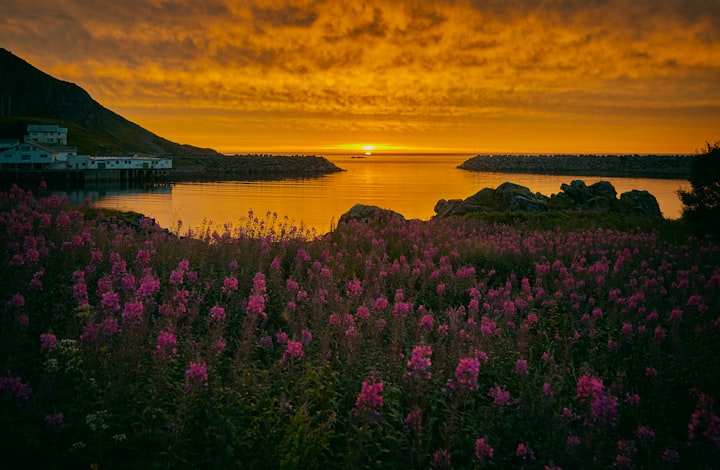
Although many Arctic Circle countries view midnight, Norway is the only country known as the midnight sun. That is why no other northern European country like Norway has ever had a wonderful night under midnight.
During the summer solstice in these regions, you can see the sun at midnight at local time, which means it is not dark. In mid-summer, from the Arctic Circle to the Antarctic Circle, the sun is visible at local time (midnight), which means it is not completely dark. Due to the reversal of the solar disk by wind, the area where the sun appears is located at a latitude between Arctic and Arctic circles, which may or may not exceed 1 degree, depending on local conditions. Because of the receding tides, and because the sun is more disk than a point, midnight can be seen in areas south of the Arctic Circle or north of the Antarctic Circle, although not more than 1 degree (depending on local conditions). ).
Because midnight is a phenomenon occurring north of the Arctic Circle and south of the Antarctic Circle, it occurs only in the northern parts of Norway. Midnight, when daylight lasts 24 hours, is north of the Arctic Circle, where daylight reaches five months depending on how far north. If you travel south, a short time in which the sun can see midnight; in northern Norway Midnight, the sun is visible from late April to August.
Norwegians living in the northern parts of Norway see a midnight sun about two months a year in the summer. One of the best places to see the legendary midnight sun in the south of northern Norway (and fold your tongue along the way) is the Helgeland region, just below the Arctic Circle. In some regions of Northern Norway, daylight shines all night for two months during the summer, accompanied by beautiful sunsets in the north. These regions receive more than 20 hours of sunlight during these two months.
Since Earth's axial tilt is important, the sun does not set in these areas for some time. The Earth is actually about 23.5 degrees tilted, which is why the Sun does not set in the middle of the Arctic Circle during the summer, and at the North Pole, the Sun does not set for a full six months. Since summer, the sun does not set below the horizon at any time of the day for 24 hours.
In the Arctic summer, the sun can shine 24 hours a day for six full months. During the summer months, when the equator is tilted toward the sun, the poles receive sunlight 24 hours a day. In summer in the northern hemisphere, the north pole is tilted toward the sun, while the south pole is tilted toward the sun, in contrast to summer in the southern hemisphere.
The longest night of the year falls during the winter, falling on December 21 in the Northern Hemisphere. The Reverse Phenomenon, a polar night, occurs in winter when the sun is below the horizon all day.
During a gloomy night, from November to January, the sun never sets in November. On a clear night, the sun does not rise in full force, covering the earth with blue light during the day. During the long summer of Scandinavia, the sun does not set for months. In Norway, the sun never sets under the horizon in various cities, including Tromsø, from late May to July.
North Point is the same; the sun is visible 24 hours a day for about three months of the year (from May 4 to July 29). In the Northern Cape, the sun shines in the sky for over 1,800 hours without setting. In the Northern Cape, there are 1,800 hours of sunlight uninterrupted for 75 days. As mentioned above, the whole of Norway also has very long days, even when the sun goes down under the equator.
For example, in the capital Oslo, June and July have long hours of sunlight (about 19:00), and the sunsets between 23:00 and 4:00. For example, in Longyearbyen, Svalbard, the sun does not set until mid-April to late August. In Norway's Svalbard archipelago, the northernmost region of Europe, the sun does not set from about April 19 to August 23. Finland, Sweden, Norway, Greenland, and the Northern Regions of Iceland Finland, Sweden, Norway, Greenland, Iceland Enjoy Midnight Wonder During the short summer months in Northern Finland, there are 24 hours a day.
In areas where the Sun is below 6 degrees Fahrenheit (or 7 [3]) below the equator — between 60 degrees 34 (or 59 degrees 34) and the Arctic Circle — the midnight eclipse is visible instead of midnight, so at noon. activities such as reading can be done without the light of day. Above 66 ° 33 N, the sun does not set completely below the horizon in summer, and as you move north, the sun rises in the sky at night. At midnight, when the sky is usually shrouded in darkness, the sun is still visible.
Arctic Circle from Longyearbyen (midnight to midday) to mid-summer in the Northern Cape in the Northern Cape, the light is reminiscent of warm night tones and warm seas. At the top of the Arctic Circle, at Longyearbyen in Svalbard, midnight may sound like a midday summer, while in the Northern Cape the light is as bright as the evening and the sea is like a warm golden color. Although beyond the Arctic Circle the center of the Sun, by definition and without opposition to the atmosphere, is visible only on summer nights, half of the midnight sun appears across the Arctic Circle from about June 12 to July 1. From mid-May to late July, the sun sinks under the horizon for a few hours each night, ready for long days of exploration.





Comments
There are no comments for this story
Be the first to respond and start the conversation.